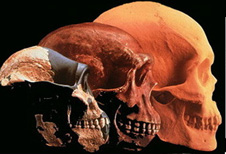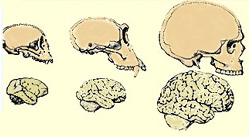Brain Size
 Intelligence can be roughly correlated with brain size at the species level, particularly if we look at the ratio of brain size to overall body size. (The whale family is an exception to this general rule.) We saw how, as humans evolved, brain size increased dramatically. We can observe at a glance in the image at left the increase in brain size and shape over 3.5 million years. The A. afarensis skull at left has a brain capacity of approximately 400 cc, about the same size as a chimp's brain. The million-year old Homo erectus skull in the center has a capacity of 1200 cc, and the modern human skull at right holds a brain of 1400 cc. The shape of the hominid skull changed dramatically to accommodate the development of a forebrain. Note that A. afarensis on the left, one of the earliest hominid species, has almost no forehead at all.
Intelligence can be roughly correlated with brain size at the species level, particularly if we look at the ratio of brain size to overall body size. (The whale family is an exception to this general rule.) We saw how, as humans evolved, brain size increased dramatically. We can observe at a glance in the image at left the increase in brain size and shape over 3.5 million years. The A. afarensis skull at left has a brain capacity of approximately 400 cc, about the same size as a chimp's brain. The million-year old Homo erectus skull in the center has a capacity of 1200 cc, and the modern human skull at right holds a brain of 1400 cc. The shape of the hominid skull changed dramatically to accommodate the development of a forebrain. Note that A. afarensis on the left, one of the earliest hominid species, has almost no forehead at all.
The image at lower left shows, from left to right, monkey, chimp, and human brains. As the human brain developed, the number and depth of its creases and convolutions also increased.
 The fossil evidence allows us to trace the gradual increase in brain size over the past two or two and a half million years with some degree of precision. The average brain size of Homo rudolfensis, far left above, who lived approximately 2 million years ago, was 750 cc. Homo erectus (next skull to the right) shows this transition most dramatically, indicating that most of the evolutionary increase in brain size took place during the life of this species. Early Homo erectus/ergaster in Africa (from about 1.7 to 1 million years ago) averaged 900 cc in brain size, but later Homo erectus specimens from .5 million years ago average 1100-1200 cc, which falls within the range of the brain size of modern humans. The H. heidelbergensis skull (top center), dates to 300,000-400,000 years ago and averages over 1200 cc. The Neanderthal skull, second from right, has a brain size of 1500 cc, which is actually larger than the brains of most modern humans. The average size of our Homo sapiens brains is around 1400 cc.
The fossil evidence allows us to trace the gradual increase in brain size over the past two or two and a half million years with some degree of precision. The average brain size of Homo rudolfensis, far left above, who lived approximately 2 million years ago, was 750 cc. Homo erectus (next skull to the right) shows this transition most dramatically, indicating that most of the evolutionary increase in brain size took place during the life of this species. Early Homo erectus/ergaster in Africa (from about 1.7 to 1 million years ago) averaged 900 cc in brain size, but later Homo erectus specimens from .5 million years ago average 1100-1200 cc, which falls within the range of the brain size of modern humans. The H. heidelbergensis skull (top center), dates to 300,000-400,000 years ago and averages over 1200 cc. The Neanderthal skull, second from right, has a brain size of 1500 cc, which is actually larger than the brains of most modern humans. The average size of our Homo sapiens brains is around 1400 cc.
 While there is rough correlation between brain size in relation to overall body size and intelligence, scientists caution that that correlation is very loose. Human brain size varies considerably, just as body size does. The brain size of recognized "geniuses" can vary from 1000 cc to 2000 cc in modern humans. Clearly, one has to examine far subtler features of the brain to understand the relations between physical characteristics and intellectual capacities or between brain physiology and social or cultural behavior.
While there is rough correlation between brain size in relation to overall body size and intelligence, scientists caution that that correlation is very loose. Human brain size varies considerably, just as body size does. The brain size of recognized "geniuses" can vary from 1000 cc to 2000 cc in modern humans. Clearly, one has to examine far subtler features of the brain to understand the relations between physical characteristics and intellectual capacities or between brain physiology and social or cultural behavior.
Surprisingly, a big brain was not an obvious evolutionary advantage – at least not immediately. For example, a large brain requires an inordinate amount of care and feeding, including a diet high in protein, and exquisite temperature control in order to function properly. Increases in brain size would therefore drive changes in early human diets, because of the need to increase the intake of protein. While human species remained omnivorous, a preference for meat-eating is visible over time and can be measured through chemical analysis of bones. In modern humans, about 25% of our metabolism is devoted to brain function, which represents a huge investment of energy – and therefore a huge risk in terms of the overall chances for survival of the species. Overheating the large human brain in the hot climate of east Africa carried the risk of heatstroke and even death. To see how our ancestors evolved solutions to this problem see the section on heat diffusion.

